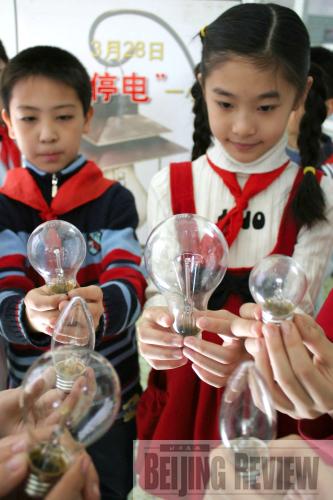|
 |
|
TURN OFF THE LIGHTS: Students at a school in Hexi District of Tianjin participate in the one-hour activity of turning off lights all over the world on March 27 (LI XIANG) |
The glow of electric lights illuminating the nights of ever-brighter cities has been regarded as one of the signs of prosperity and modern civilization. And when darkness draws the curtains on Chinese cities, a bevy of diverse lighting systems come on. Some cast beams on the walls of buildings, others radiate neon glow advertising, and still others light the way for streams of traffic. Others come on from the traffic itself.
But all this comes at a price. More and more people have realized that when the cities become brighter and brighter, they must sacrifice the stars. It is still not that long ago when stars provided the main source of illumination for towns, but now their subtle glow is all but lost in the competition with electric power.
Modern societies all must deal with the five major sources of pollution resulting from industrialization—light, water, air, noise and solid waste.
Light interference rising up from cities has caused serious problems for astronomical observation. In some big cities suffering from severe light pollution, as few as 25 stars may be visible. Although telescope technology has vastly improved over time and has, to some extent, been able to counter the interference, most of the observatory stations around the world built near cities have either scaled back operations or moved to more remote locales.
More than 60 years ago, some professional and amateur astronomers began a campaign against light pollution to protect the observation stations. But now in 2009, the year set by the International Astronomical Union and the UN Educational, Scientific and Cultural Organization as the International Year of Astronomy, scientists are taking the opportunity to tell people all over the world that a dark night is a precious resource. As part of their advocacy for the dark, they are asking people to shut off their lights for one hour from 8:30-9:30 p.m. on March 28, June 21 and August 22.
But scientists say light pollution is more than an annoyance to astronomers. They say it can also have a subtle impact on culture. Lacking the direct visual connection to the starry sky, people lose their perspective on the vastness of the universe and their place in it. This, they say, is changing children's understanding of nature. "A child once told me he was surprised to know that the galaxy really does exist. He thought that it only existed in cartoons," said Jiang Xiaojun, Chief Engineer of Xinglong Observation Base-China's National Astronomical Observatory.
Bian Yulin, an astronomer and science writer, said staring at the stars as a child has directed his career. "Protecting the natural night sky is fundamental not only for scientific research, but also because it cultivates people's curiosity. This is very important," said Bian.
But all that nighttime light is also hitting people in their wallets. Data from the International Dark-Sky Association show that the global cost of superfluous lighting runs into hundreds of millions of dollars annually. When darkness falls, the "night fog," which forms from the excess light emanating from ground level, lingers above many cities.
Xiao Huiqian, chief engineer with the China Academy of Building Research, conducted research in Beijing, Shanghai and Guangzhou. He found that only 5 percent of the light from street lamps reaches the road, while the other 95 percent is wasted. When the source of the electricity is taken into account, the true nature of the inefficiency comes into sharper focus. Two thirds of the energy needed to light China comes from thermal power generation and three fourths of generation is accomplished by burning coal, itself an inefficient process. The wasted light, then, can be seen not just as a drag on the night sky, but also as a waste of valuable and polluting finite resources.
This artificial daylight also seeps from homes and businesses through windows into the overburdened environment. Even if people grow accustomed to all the artificial light, it still causes harm to other animals and even kills them.
| 